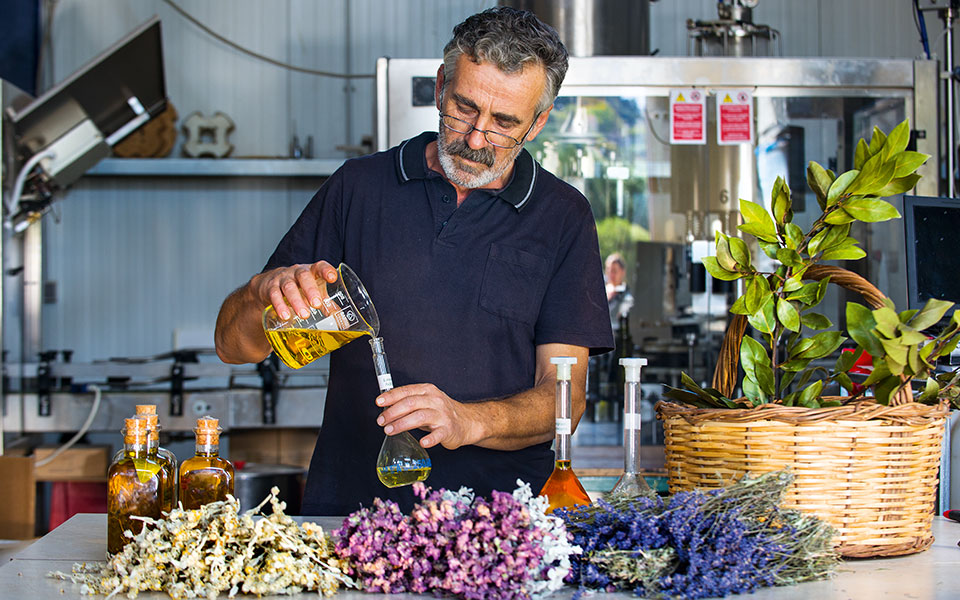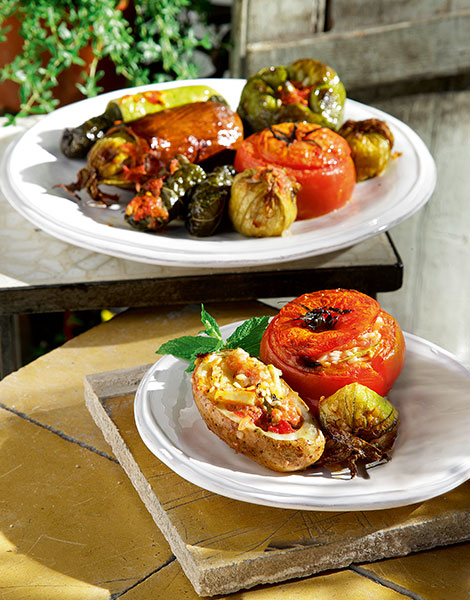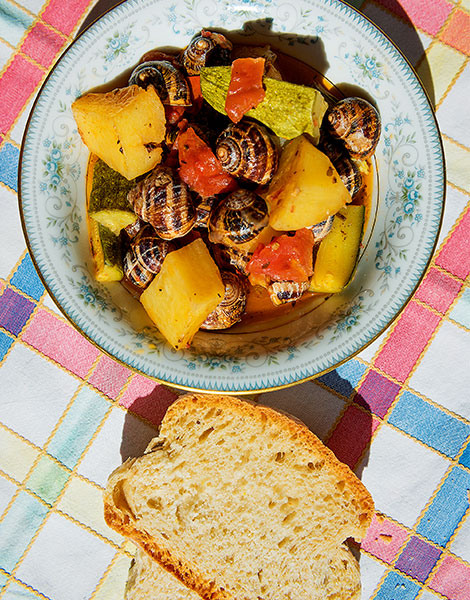Cheeses
Without a doubt, you’ll find the tastiest cheeses in the mitata (shepherd’s huts), not only in Rethymno (the region that lays claim to some of the finest cheeses on Crete) but throughout the island. Left to mature in the cool dry-stone interior of the huts, these simple creations are first formed in a cauldron. Usually unpasteurized, they have the delicate fragrance of fresh milk.
Cheeses in this category include tyrozouli and kefalotyri. Unfortunately, their production is limited, so to find them you’ll have to go to the source, that is, up to the mountain huts. Most shepherds will be willing to provide you with some, and may even offer you a shot of fiery raki by way of a welcome.
While on Crete, there are several fresh cheeses worth tracking down. Too delicate to travel, these aren’t exported; they include xinomyzithra (the sour variety), glykia myzithra (the fresh, or sweet variety) and xygalo Sitias.
You should also make room in your luggage for some graviera, generally considered to be the queen of Cretan cheeses. This can be sweet or peppery, depending on how long it has been aged. If you’re in Hania, Flemetakis in the covered market offers a wide selection of long-aged graviera from Mylopotamos and the Amari Valley. We recommend graviera from the dairy Gasparakis in Koumi, Rethymno (Tel. (+30) 28310.410.72); goat cheeses from the Tyrokomio dairy in Karines, Rethymno (Tel. (+30) 28320.223.60); or the dry anthotyro whey cheese of the Vogiatzidakis dairy in Roustika, Rethymno (Tel. (+30) 28310.912.09).
You can purchase all these cheeses directly from the dairies or look for them in grocery stores throughout the region.

© Dimitris Vlaikos

© Dimitris Vlaikos
BREAD RUSKS
The best-known Cretan paximadi (bread rusk) is called a dakos and is made with barley. In many villages, traditionalists still make this double-baked bread with a combination of barley and wheat flour from a recipe they keep secret, because they believe that if they reveal it, subsequent attempts to make it will end in failure.
You’ll find lots of paximadia in the regions of Irakleio and Lasithi. The most delicious we’ve tasted are in the village of Kroustas in Lasithi, at the Kroustas Taverna. For a more wheaty flavor, try paximadia from the bakery Mystraki in the village of Atsipopoulo, Rethymno. Kneaded by hand and formed into a ring shape with a hole in the middle, then baked in a wood-fired oven, these paximadia are as fluffy and tasty as freshly made bread. You’ll find them at grocery stores and restaurants all over the island. Ask for them by name, or visit the bakery itself, just 6km from Rethymno.
In recent years, paximadia made with carob flour have become all the rage. This particular variety has an earthy flavor that many liken to cocoa.
Honey
Foraging bees collect nectar from herbs and other plants considered by many Cretans to have medicinal properties, such as thyme, ironwort (Cretan mountain tea), sage, oregano, heather and white thyme, as well as from acacia and pine trees and strawberry plants.
Ask about local small-scale producers in village coffee shops and taste the product before buying. You’ll also see plenty of honey in labeled jars or tins; look out for Cretan Zelkova honey from the Irakleio-based producer Marousis (available at the grocery store Alati tis Gis, (4 Giannitson, Irakleio), or the pine and thyme honey of the Meligyris apiary at Arkalochori, Irakleio (Tel. (+30) 28910.290.66).

© Effie Paroutsa
Olive oil
Now we come to the secret behind the exquisite cuisine of Crete – olive oil. The main olive variety is the Koroneiki, although some producers also make oil from Tsounati olives, which are wonderfully flavorful but have a low yield per tree.
There are dozens of brands of bottled olive oil that have won awards in international competitions. It’s definitely worth looking out for the olive oil from the Vassilakis Estate (Tel. (+30) 28410.336.53) in Mirabello, Lasithi. The estate also sells delicious Mouratolia olives, an outstanding product prepared in small batches and sold in little glass jars, soaked in a special brine of herbs, local vinegar and sea salt.
At Pamako (Tel. (+30) 28210.514.21), in Lentariana outside Hania, you’ll find organic, ultra-premium, extra virgin olive oil that’s a delight for the taste buds and which, thanks to its high phenolic content (higher than the EU threshold for health products), can be sold abroad as a food supplement.

Herbs and plants
The Cretan mountains are blessed with an abundance of herbs and aromatic plants. Ironwort, dittany, sage and pennyroyal have long been identified as natural remedies, with antioxidant, antiseptic and other beneficial properties. They can be used either to create fragrant infusions or as ingredients in numerous recipes.
Go for the packaged varieties, since the herbs and plants come from certified producers who, by cultivating them, are helping to preserve the island’s biodiversity. Many people on Crete, especially the elderly, know how to identify and collect them in the wild.
Xerotigana
These fried pastry strips, soaked in honey and sprinkled with nuts, are served at weddings and other celebrations. You’ll find them at bakeries and pastry shops. If you’re in Siteia or Irakleio, try these sweet treats at Aretousa (23 Eleftheriou Venizelou and 19 Kosmon, respectively).

© George Drakopoulos

© Perikles Merakos
Homemade delicacies
Baby artichokes and askordoulakia (tassel hyacinth bulbs) are pickled in a mixture of olive oil, salt, and vinegar or water and stored in glass jars. These slightly bitter, salty or acidic delicacies – often hard to find – are widely considered to be the best meze to serve with raki. In the small villages of the island, ask where you might find some; your best bet is probably the women sitting and chatting outside their homes.
Raki/Tsikoudia
Poured cold into tiny glasses, it is served as a welcome drink, raised to mark an agreement, clinked at celebrations, and refilled before leaving. Served alongside bread rusks and cheese, it’s an aperitif, and with watermelon, a perfect digestif. The locals consider it a remedy against aches and disease – pretty much anything can be cured with tsikoudia – and when distillation takes place in October or November, professional distillers and amateurs throw days-long celebrations.
To bring raki home, buy it bottled from licensed producers. We especially recommend the tsikoudia from Toplou Monastery in Lasithi, Vassilakis Estate in Mirabello, Kedria distillery in Hania and Manousakis winery (made with the Roussanne grape variety), also in Hania.

© Illustration: Philippos Avramides
WHAT’S WHAT?
Mitata: These are architecturally distinctive stone huts used as seasonal residences by shepherds in the mountains. The circular, dry-stone structures not only provide good shelter from often harsh weather conditions, but are also used for aging cheese made immediately after milking.
Xygalo: Traditional cheese spread with a refreshing sharpness and slightly sour taste. It is usually made from goat’s and/or sheep’s milk and is low in fat. Xygalo Sitias enjoys PDO status.
Askordoulaki: The scarce bulbs of the wild blue tassel hyacinth are considered a delicacy, but must undergo a certain process to remove their natural bitterness: after being scored, they are left to soak in water for many days, then stored in glass jars in vinegar or brine. It’s the ideal accompaniment to raki (aka tsikoudia) and a favorite ingredient in roast lamb.
Kapriko: Slow-roasted pork, generally served at local festivals. The hours-long cooking process results in a crispy, crunchy outer crust and very tender, melt-in-the-mouth meat.
Skioufikta: Handmade tubular pasta, usually cooked in a meat broth and served with a topping of grated dry anthotyro cheese.
Tyrozouli: Produced in shepherds’ huts and in homes, this is made from sheep’s or goat’s milk, which is curdled with the help of vinegar, lemon juice or some other acidic agent. The curd is poured into molds – plastic or straw baskets and left to drain. It’s extremely tasty when soft and fresh, especially with honey.
Xinohondros: traditional homemade pasta made from fermented milk and cracked wheat grains (bulgur). It has a slightly sour taste and strong milk aroma. This dish was often seen as fare for the poor; even in poverty-stricken Cretan homes, there would usually be some wheat and milk. With a little onion, tomato and potatoes, xinohondros provided a filling meal for the entire family. For a special treat, snails are added.
Anthi: Zucchini flowers stuffed with rice and herbs, either cooked with lemon juice in a pot or roasted in the oven.
Eftazima: These delicious rusks or breads are made using ground chickpeas as a starter dough. Each household creates their own variation and does not reveal the recipe, on account of the superstitious belief that doing so would mean the dough would never rise again. The rusks are only made on certain days, usually religious feasts or during particular lunar phases.
Ladera: Loosely translated as “[olive] oil-based,” some of the best-known dishes of Greek cuisine are cooked this way. The recipe usually calls for vegetables cooked with onions, garlic, grated tomato, herbs and copious amounts of olive oil. Whether cooked in the oven or a pot, these basic ingredients create a truly delicious red sauce. Dishes in this category include yemista (stuffed vegetables), imam (stuffed eggplant) and green beans.
Antikristo: Lamb or goat cooked “facing the fire.” This technique was used by shepherds who, in the past, did not have grills or pots up in the mountains where they spent much of their time. They would instead cut the animal into four parts (goulidia), season the meat with plenty of salt, pierce it with wooden skewers and place the parts around the fire, supported by a rudimentary frame. Nowadays, the meat is cut and roasted the same way, the only difference being that metal supports are used for the cooking process.
Hohli: Snails are a popular ingredient in Cretan cuisine. They are often cooked in a frying pan with rosemary and vinegar, a recipe known as boubouristi, but they are also added to red-sauce vegetable dishes. One very popular dish is bulgur with snails and potatoes.












